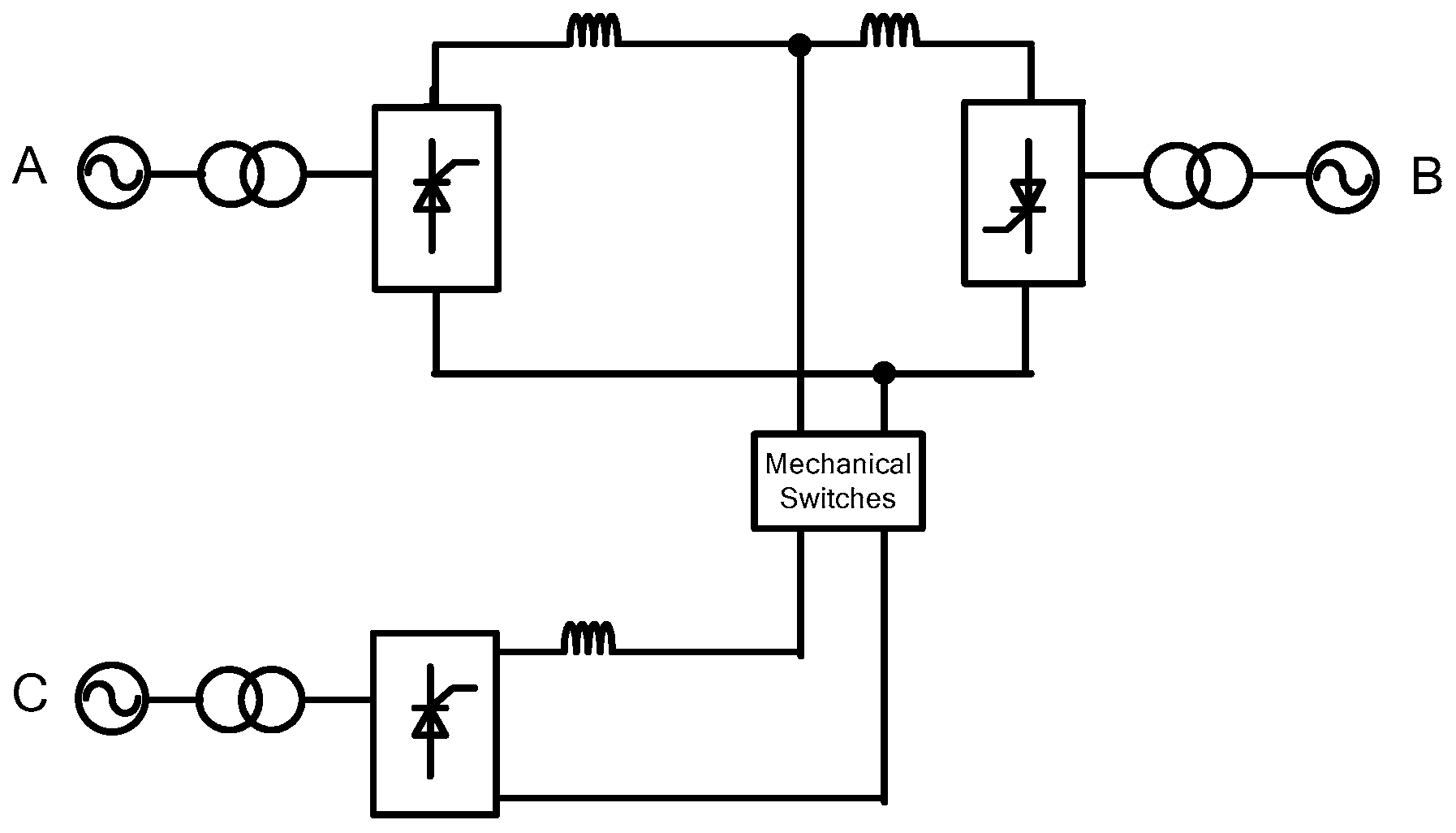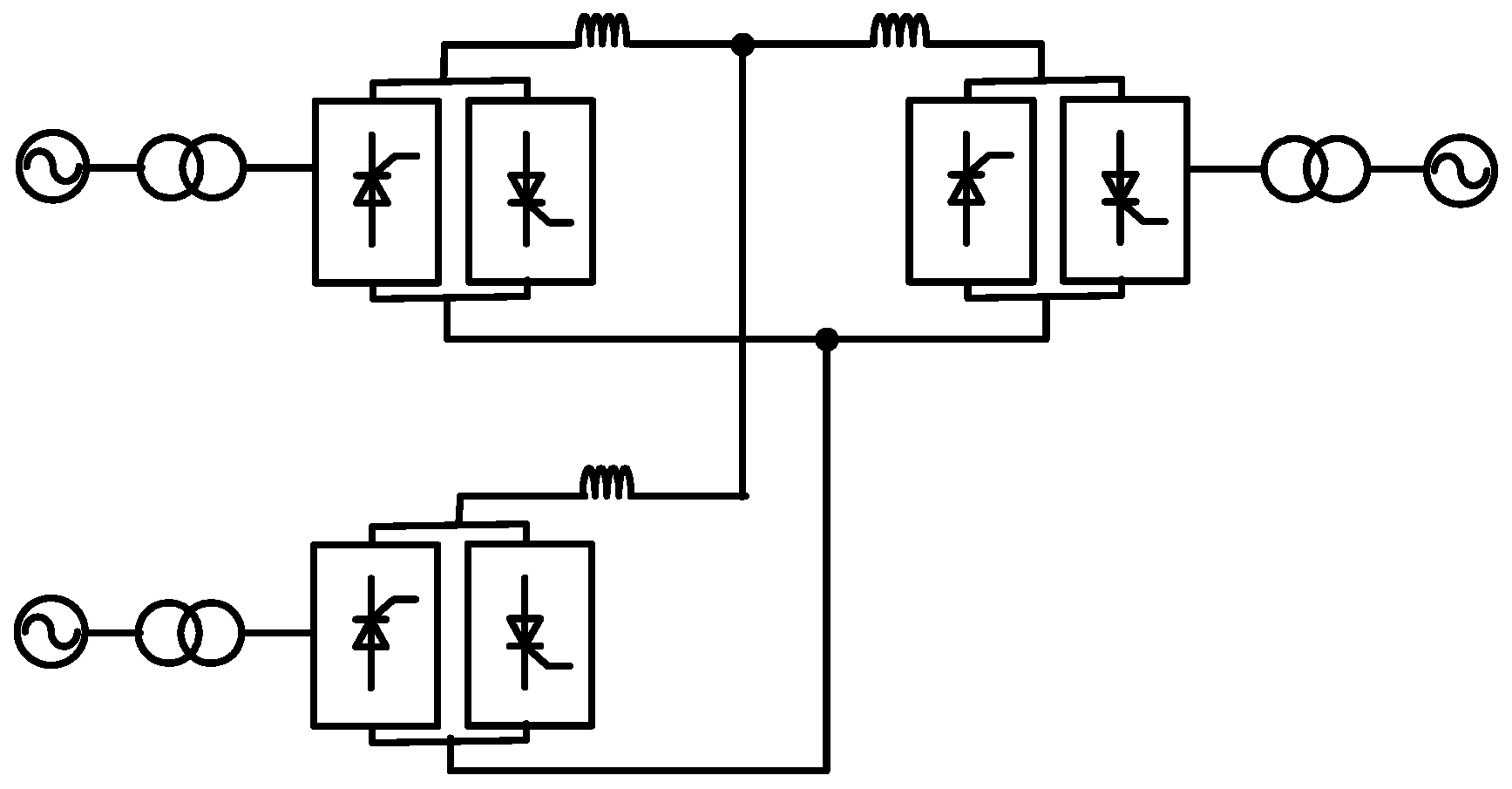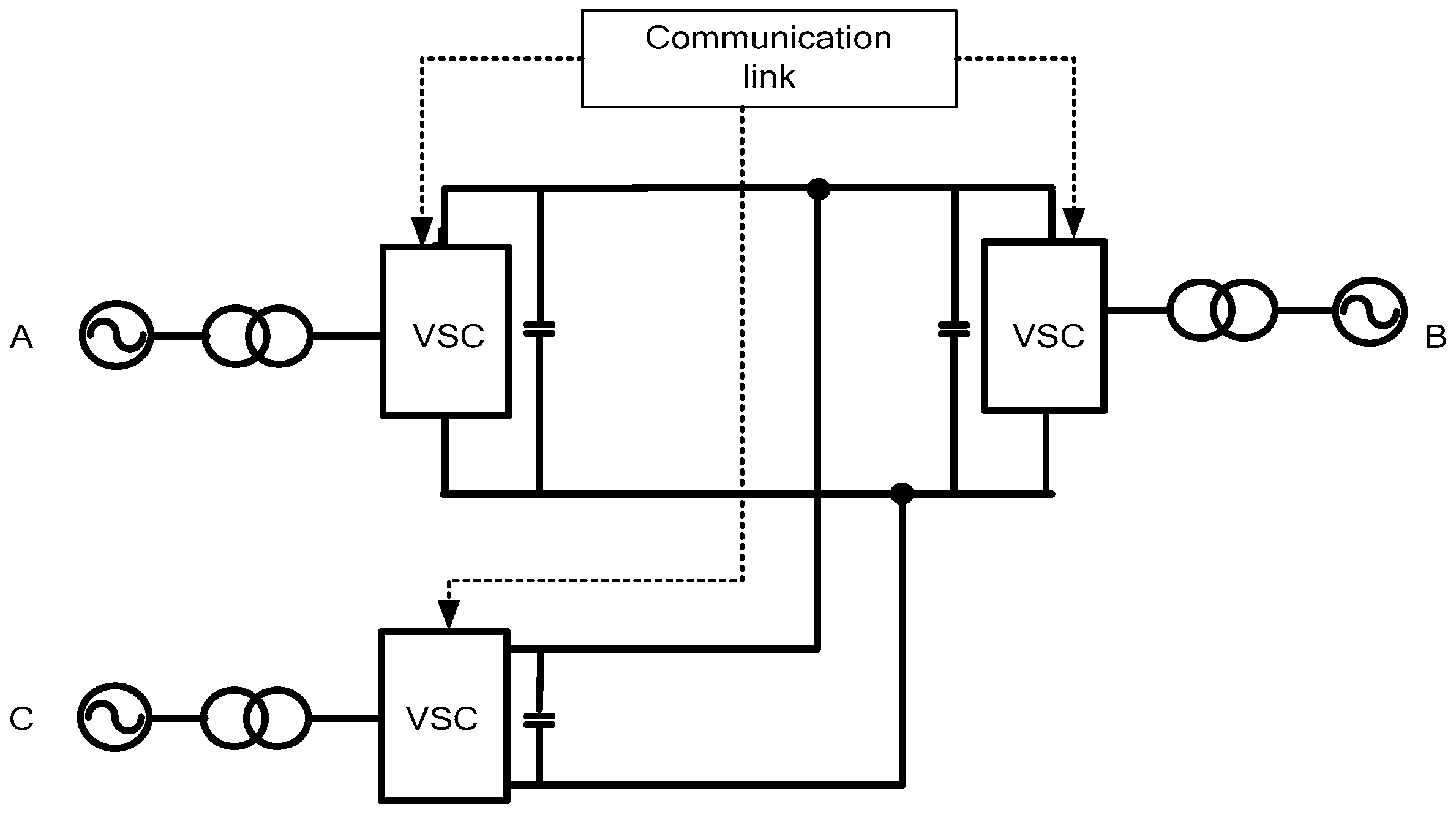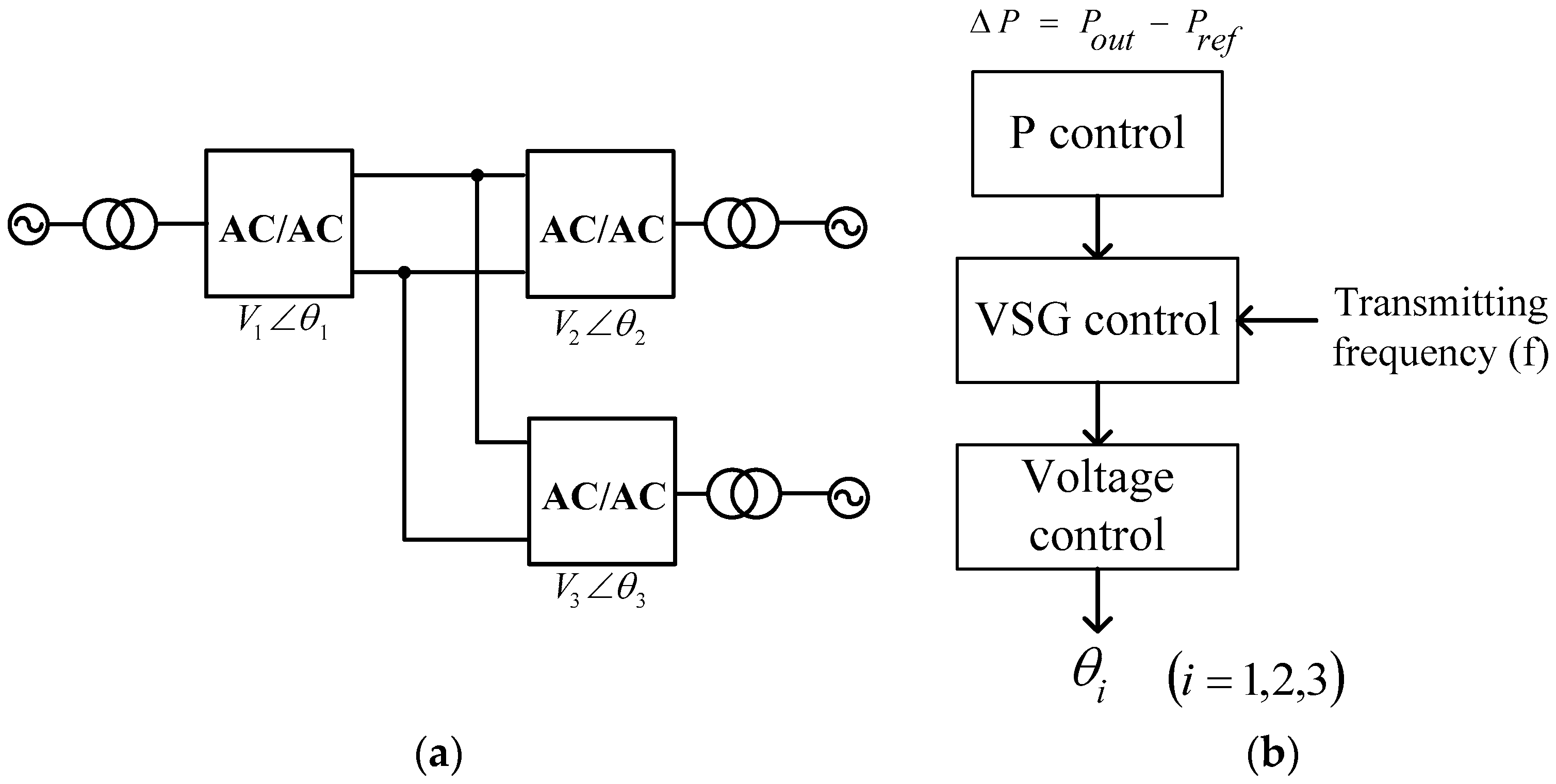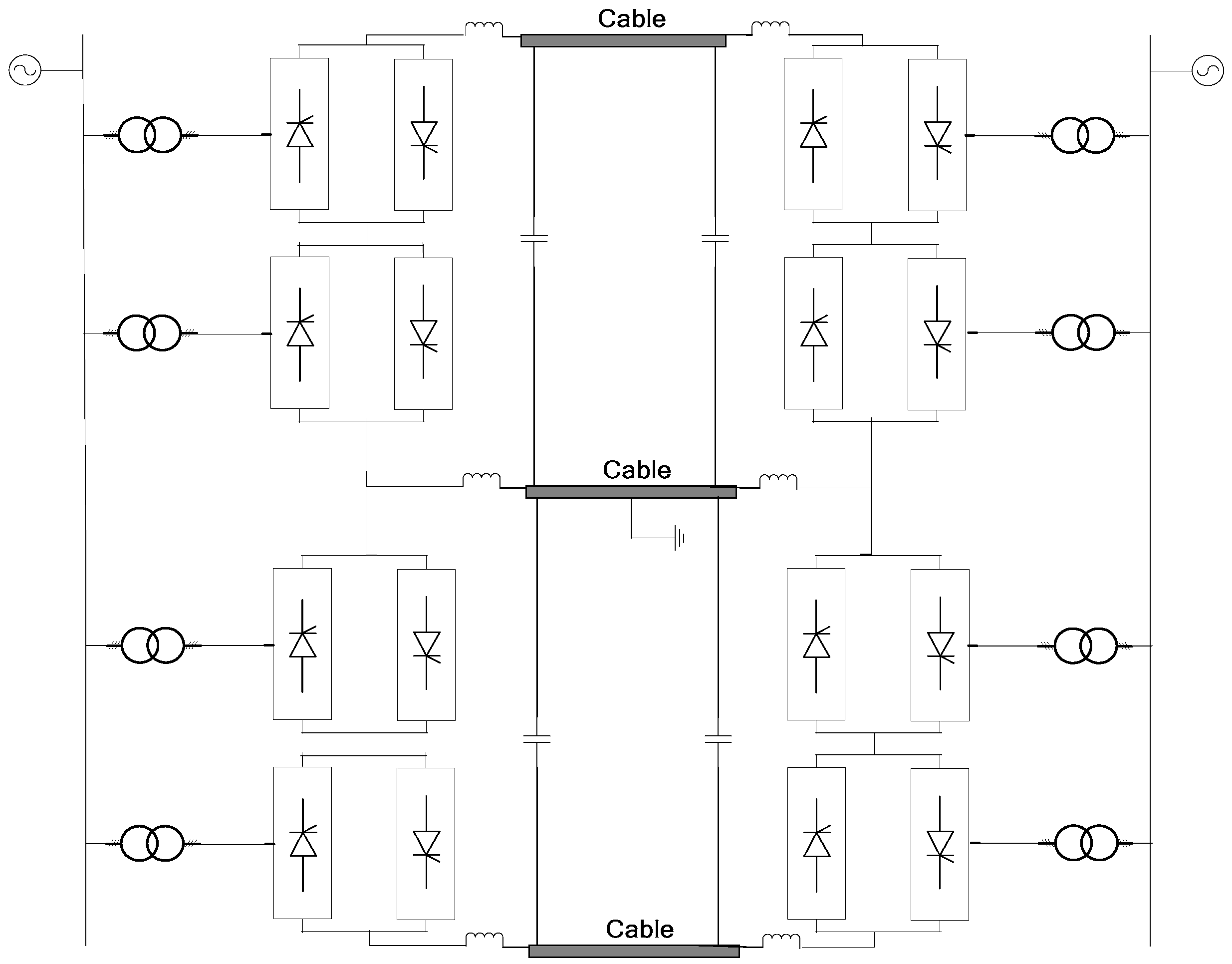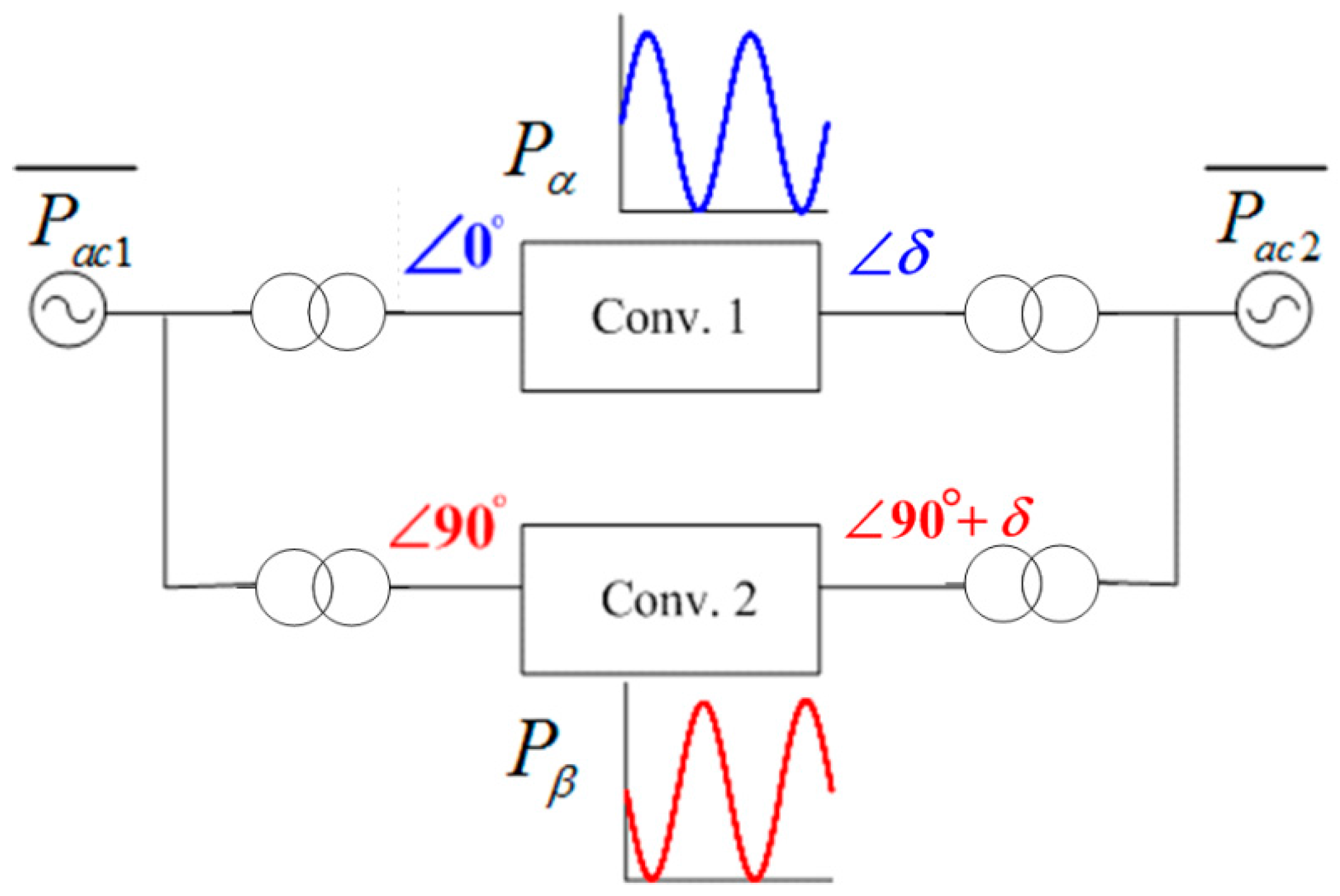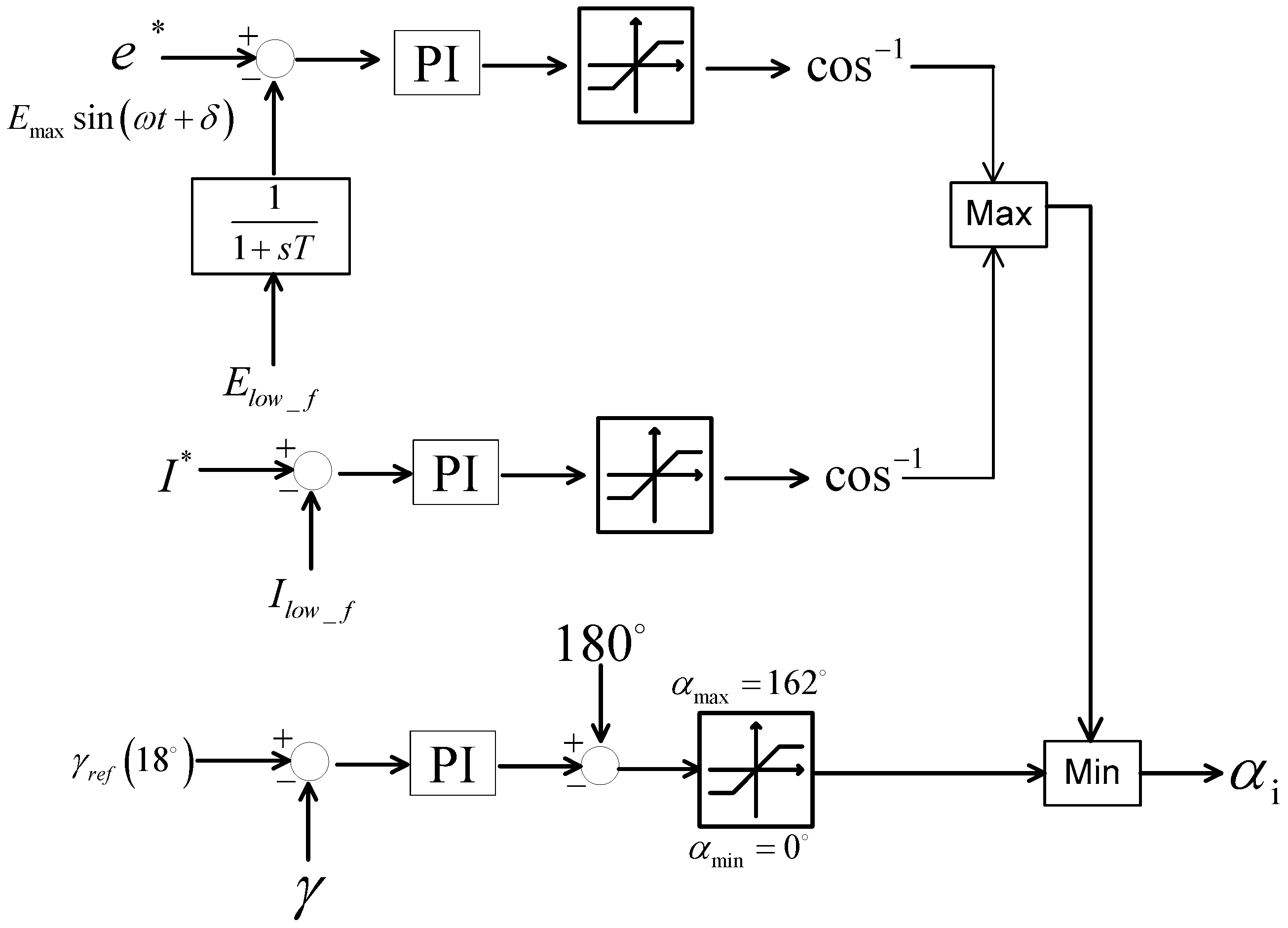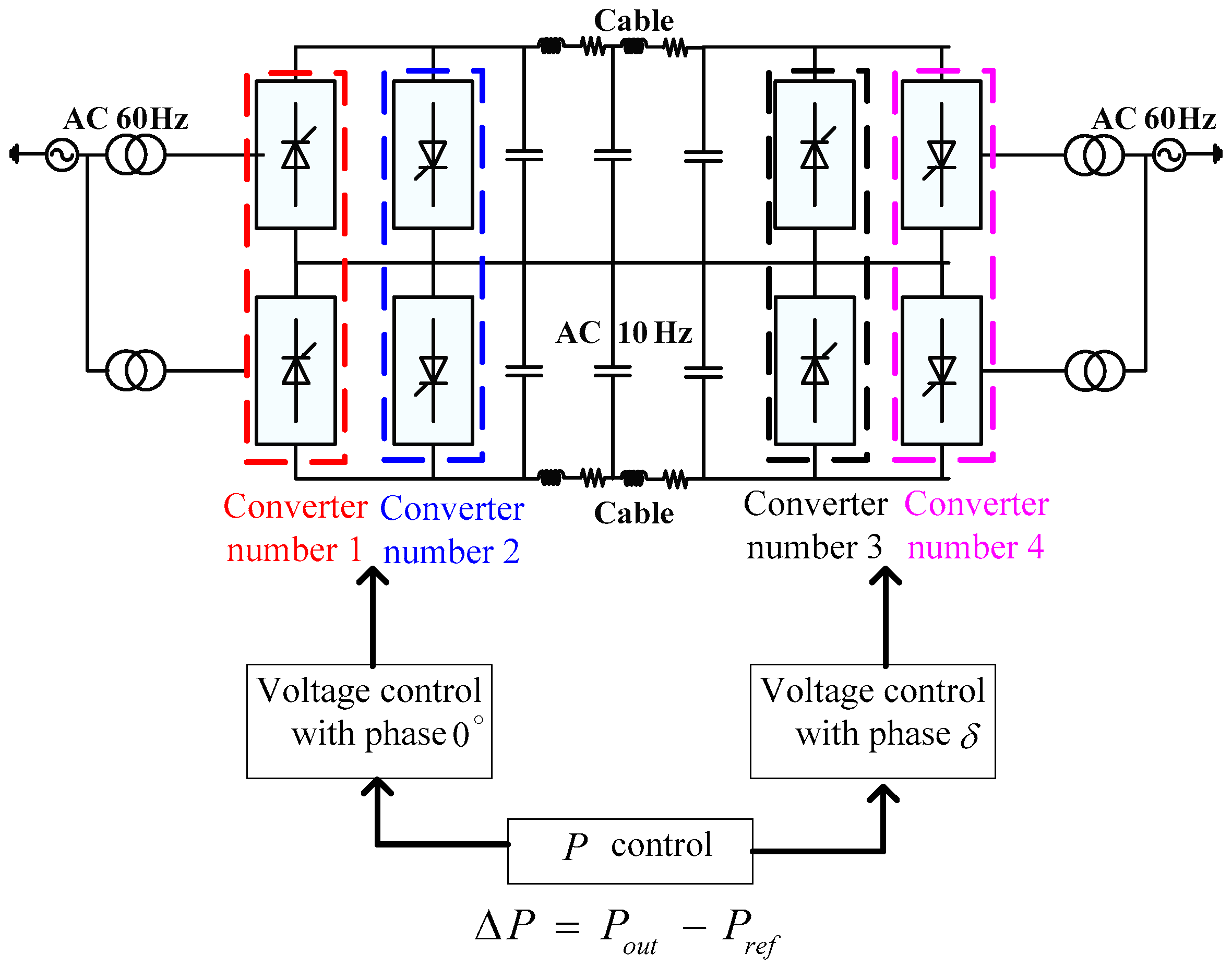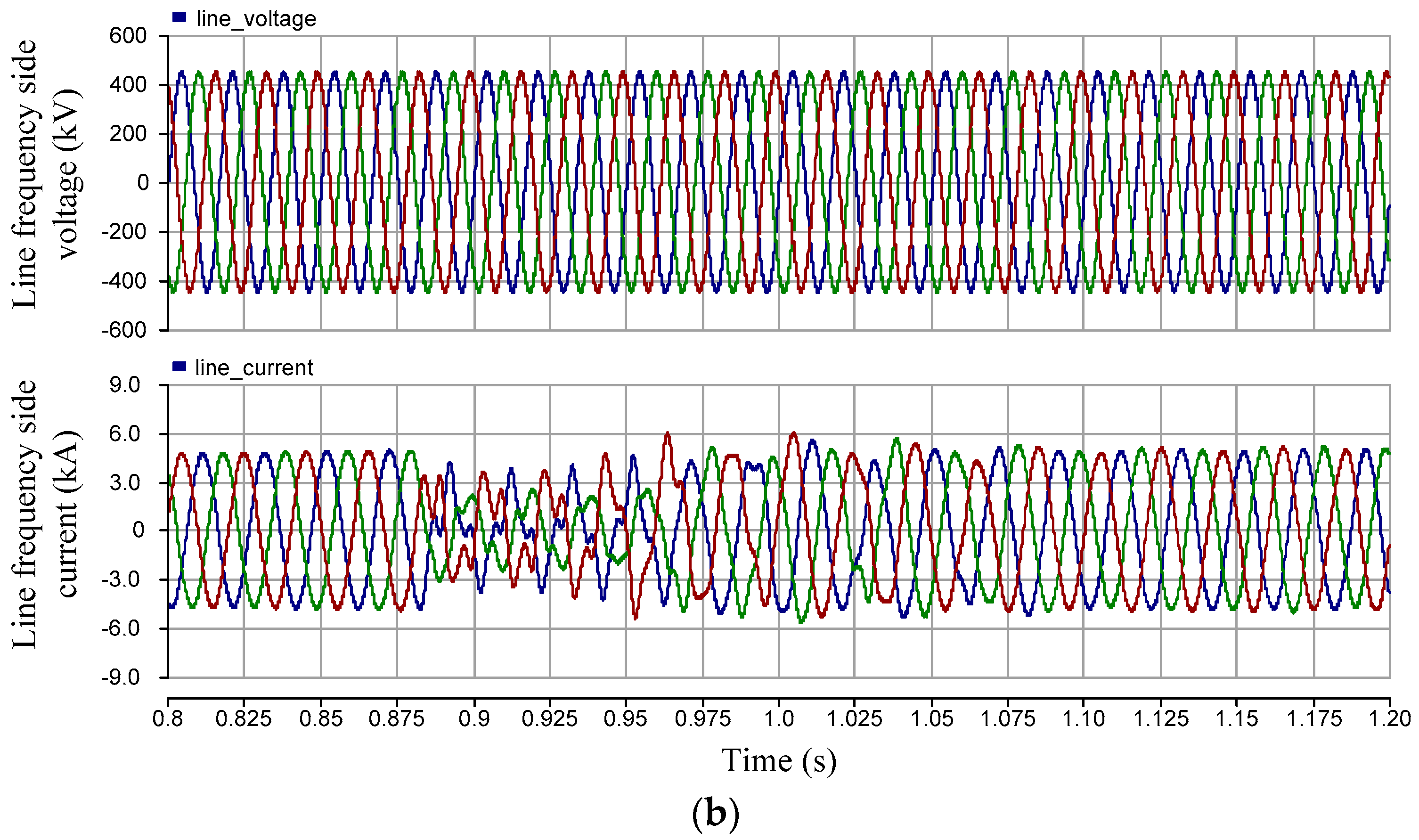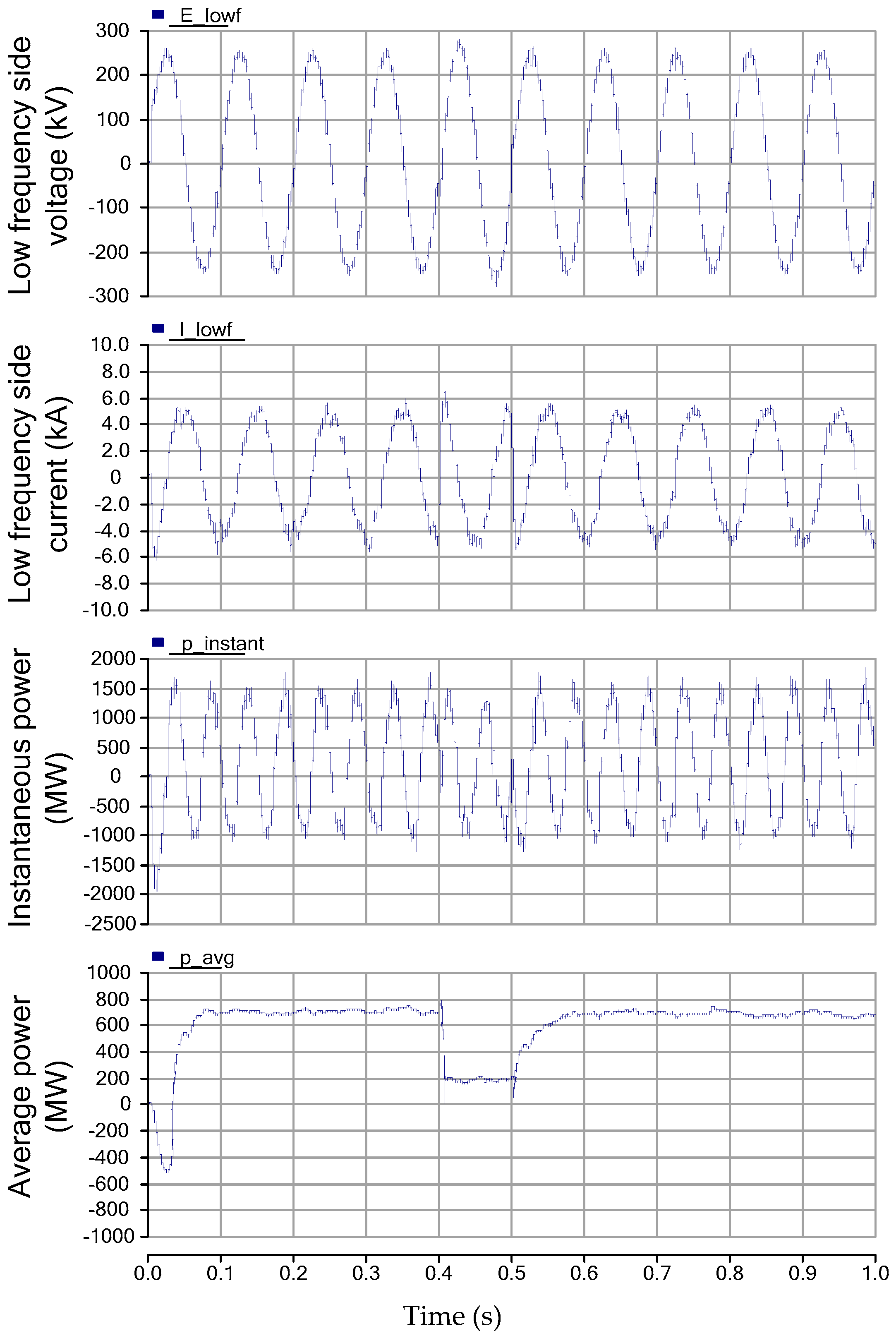1. Introduction
High Voltage Direct Current (HVDC) is widely applied for point to point connection between power systems. Since HVDC cable transmission is not affected by the capacitance, HVDC systems are feasible for long transmission line lengths. However, when increasing the interconnection using HVDC for off-shore wind turbines, multi-terminal HVDC (MTDC) is utilized. Currently two basic converter technologies, conventional Line-Commutated Current Source Converters (LCC) and self-commutated Voltage Source Converters (VSCs) including Modular Multi-level Converter (MMC), are mostly used in the HVDC systems.
LCC-HVDC still remains the dominant technology for long distance bulk power transmission due to its lower investment costs and much higher maximum power transfer capacities. It is naturally able to withstand short circuit currents due to the fact the DC inductors limit the current during fault conditions. Power reversal in MTDC however usually needs a complicated switching technique in the case LCCs are used [
1].
On the other hand, VSC-HVDC systems are sensitive to DC line faults. When a faults occurs on the DC side of a VSC-HVDC system, an insulated-gate bipolar transistor IGBT cannot control it and the freewheeling diodes work as a bridge rectifier, so it is not able to withstand large surge currents, and may be damaged before the fault is cleared. Some solutions are proposed, however additional control and the switching devices are needed.
Besides LCC-HVDC and VSC-HVDC, high-voltage low-frequency ac transmission system (LFAC) has been proposed as a promising transmission system that can be a compromise between the advantages and disadvantages of both transmission systems. The LFAC transmission system can reduce capacitive currents, and offer simplicity for over-current protection.
In general, the main advantage of the LFAC technology is to significantly reduce power losses due to decreased transmitting frequency. The increase of power capacity and transmission distance compared to the conventional (50 or 60 Hz) transmission ac system can be mentioned as its main advantages [
2]. Protection of low frequency side faults is easier than for the DC side faults of VSC-HVDC due to their zero crossing point; also the power flow direction can be changed by the phase control of the voltage on the low frequency side [
3], and existing circuit breakers can be used in this system although the interruption current is decreased to around half of 60 Hz [
4].
LFAC transmission has been studied for wind power applications due to the increasing number of interconnections between new wind power installations and the grid [
5,
6]. The capability of handling large amounts of power as more generation is injected as multi-terminal system is a positive feature of the system.
Although some studies on LFAC control schemes were carried out [
7,
8], previous investigations have not considered the various types of LFAC system configurations that could be operated in the system. Three LFAC system configurations, namely single-phase, two-phase, three-phase are studied. The rest of paper is organized as follows: the merits of the LFAC system are shown in
Section 2. Three configurations are described in
Section 3. The control scheme is outlined in
Section 4. In
Section 5, a simulation study with a comparison between each system is provided and the comparison of current ratings on the devices, number of transmission lines and current rating among the three types of LFAC are shown to evaluate the most suitable configuration for LFAC operation. Finally, conclusions are given in
Section 6.
4. Control Scheme
Here, control strategies are applied to both terminals of the cycloconverters. Power control, as shown in
Figure 10, is used to generate a phase difference δ between two terminals following the power reference. Furthermore, voltage control, as shown in
Figure 11, works with a phase difference angle to generate a firing angle
, where
i = 1, 2, 3, … is the number of the converter. In case of over current, the current limiter/control will operate to protect the devices in the system. Extinction angle control is also applied to this control scheme for preventing commutation failure in converters. Details of the control scheme are shown in [
9]. By applying this control method to the system,
Figure 12 shows the layout of the proposed control scheme with the phase difference set at 0° on one side of the converter.
5. Simulation Results
5.1. Simulated System
To demonstrate the validity of the proposed LFAC system, simulations have been carried out using the tool of the PSCAD/EMTDC software for an LFAC system as shown in
Figure 13. The maximum power transfer is rated at 1400 MW, and the transmission distance is 500 km. The system parameters are listed in
Table 1. The transmission power cable is modeled by cascading 50 sections of model cable. Considering low frequency transmission decreases losses in the transmission line, however, too small a value may affect the response time of the system as mentioned in [
5]. For a transmission frequency at 10 Hz the delay at the power reversal point is only 0.1 s, and this frequency is used for transmitting power to the transmission target at 500 km distance, so 10 Hz is chosen for this system.
For the operations of this system, each side consists of three phase (Y-∆) and (Y-Y) transformers and two sets of 12-pulse ac-ac converters connected to the power cable. At the sending point (terminal), the cycloconverters work as a frequency converters changing from the utility ac input voltage at 60 Hz to low frequency during power transmission via the cables. At the receiving terminal, another set of cycloconverters works as frequency converters by changing the low frequency to 60 Hz of ac voltage. This procedure can be performed by the proposed configurations as stated in
Section 3.
The filters on both sides of the system are low pass filters for receiving the generated ripples and undesirable harmonics from the transmission system. Knowing this fact one can calculate the filter parameters concerning the switching frequency of the power electronics converters.
The length of cable is 500 km and transmission frequency is set at 10 Hz for the simulation. The cable model with nominal parameter values is shown in
Figure 14.
This cable model is used in all proposed low frequency transmission system configurations. The cable model parameters can be calculated from Equation (2) [
10], and the transmission power cable is modeled by using single-core crosslinked polyethylene XLPE underground power cable from ABB (Power and automation technologies, Zurich, Switzerland) with the parameters values of
D = 139.2,
d = 112.8 and
= 2.3 for the XLPE:
where
D is outside diameter of the insulation, and
d is inside diameter of the insulation.
5.2. Power Fluctuation
In the performed low frequency ac transmission system, several types of phase number can be operated for transmitting power. As mentioned previously in the configuration section, single-phase, two-phase and three-phase types are considered for choosing the most suitable system for this transmission system.
To consider the application on three types of LFAC transmission system, the simulation is performed with the parameters given in
Table 1. The simulation results are given for both the low frequency and line frequency sides.
The reference transmission frequency of 10 Hz and reference amount of power of 1400 MW is considered in the transmission system. From the simulation results,
Figure 15 shows the active (
) and reactive power (
) waveforms on the line frequency side of the single-phase, two-phase and three-phase configurations, respectively.
As a result, the single-phase system has a fluctuation in power, while the two-phase and three-phase ones do not show any fluctuation on the line frequency side. From the line frequency side point of view, the single-phase system obviously has more fluctuation than the other systems. The two-phase and three-phase systems have constant active and reactive power, without fluctuation.
5.3. Ratings of Valves and Transmission Line
With the same transmitting rated power and transmission distance (500 km), the comparison results are shown in
Table 2 and
Table 3.
Table 2 shows the results of valve peak voltage, number of valves per station, valve peak current and average current of LCC-HVDC and three types of LFAC by using valve voltage and DC current of LCC-HVDC system as a based voltage and current.
Table 3 shows the results of comparison for transmission line and neutral line currents. The comparison results are obtained by the calculation from Equation (3) for the HVDC and Equation (4) for the LFAC system with the assumption of the same transmitting power for all cases.
Figure 16 illustrates the overall configuration applied for this evaluation. The output waveform of thyristor current, as shown in
Figure 17 can confirm the calculation results.
The calculation formulas for HVDC are as follows:
where,
: Valve peak current;
: Current on DC side;
: Root mean square (RMS) current on DC side;
: Average current on valve;
: Neutral current.
The peak and average currents for LFAC system are given by:
where,
: Valve peak current;
: RMS current on low frequency side;
: Average current on low frequency side.
From the comparison results given in
Table 2 and
Table 3, it can be seen that the LFAC and LCC-HVDC have the same valve voltage RMS value. Three-phase type LFAC has the lowest value of average current, thus leading to low power losses during operation. This configuration also has the lowest RMS current of transmission lines, which affects the size and cost of transmission line in the system. However the numbers of valve devices are the largest compared to the other systems, which negatively affects the size and cost of the frequency converter station. In the case of a two-phase system, it has the same number of devices as the single-phase type, but the average current is lower than in the LCC-HVDC system, the number of cables is the same as LCC-HVDC and the single-phase system, while the neutral line current is large, which is the main demerit of this system compared to the others. For these reasons, two-phase and three-phase systems should be chosen considering the length of transmission. For longer transmission systems, a three-phase system is more suitable.
5.4. Power Reversal and System Disturbance Simulation Results
As for two-phase LFAC, the reference frequency used is 10 Hz, the transmitted reference power is 700 MW.
Figure 18a shows waveforms of voltage E_lowf, current I_lowf, instantaneous power p_instant, average power, p_avg and reference value of transmitted power p_ref on the low frequency side. The power reversal starts at t = 1.
Figure 18b shows voltage and current waveforms on the line frequency side (60 Hz) at around 1.0 s, which is near the transient change of the power reference. With these simulation results, it can be confirmed that the proposed control scheme properly works for the LFAC transmission system.
To evaluate the system response in the presence of faults or disturbances, a step change in reference power is applied. In normal operation the system is operating at a power reference of 700 MW, then the reference power is suddenly changed to 200 MW for one cycle. As can be seen in
Figure 19, the closed-loop system remains stable and returns to normal operation in a short time.
